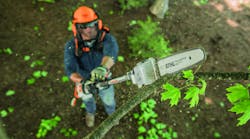When debating the merits of gas vs. battery-powered vehicles, each side has valid premises: electric vehicles cost more and there’s a scarcity of charging stations, while conventional cars cost about three times more to operate and emit greenhouse gases. For landscaping equipment, historically there really has been no debate. Gas-powered pruners and trimmers and edgers just have more oomph, and power is everything when you’re pureeing plant matter. But as the power source has evolved from the mercurial Nickel-cadmium batteries to the more stable Li-ion, the answer is not so clear cut anymore.
Conventional wisdom is that unless your greenspace is the size of a postage stamp, battery-powered equipment just wouldn’t hack it. Having lived a few hundred yards from Lake Erie, where invasive prickly vines creep from the woods like a horde from The Walking Dead, I learned a wimpy electric weedwhacker was no match, and upgraded to an edger powered by combustion. It was stronger, but more difficult to operate, with several startup switches to toggle an awkward pull cord. When it wasn’t seizing up, it worked great.
While that’s merely an annoying arrangement for someone stewarding a small strip of land, it’s wholly untenable to manicure the swaths of greenery outside your industrial facility or job site. Fortunately, this year STIHL, the national leader in gas-powered outdoor tools, released the KMA 130 R KombiMotor ($350), a first-of-its-kind powerhead that runs off an external battery and works with 13 STIHL attachments that were designed to run off gas motors. These include a blower, pruner, hedger trimmers, edgers and more.
"With one powerhead, professionals can streamline their operations by saving on storage space and maintenance of multiple units," says STIHL product manager Mike Poluka, who adds that despite being lighter weight, quieter, cleaner, and easier to use, "it delivers gasoline performance."
The KMA 130 R employs a brushless electric motor and variable speed trigger for three power settings to conserve energy, with a maximum 8,500 RPM and blower air velocity of 130 mph.
The gas equivalent KM 131 R ($399) uses a 1.4 kW engine and is more powerful, weighing 9.7 lb. compared to the KMA 130’s 7.1 lb.
"That doesn’t sound like much, but running it all day long, that 2 pounds make a difference," says Poluka, who sold STIHL products at a Pennsylvania hardware store throughout high school and college.
Despite nearly two decades of experience, he undersold how important this really is. I went to a local STIHL dealer to compare the two and the weight difference feels far greater. The KMA 131 has a wider head and looks like a hammerhead shark compared to the slimmer electric version. That makes it top-heavy, even without gas in the 24 oz. tank.
The load isn’t completely eliminated, just shifted from the arms to the hip (when using the 3.96-lb. AP 300 S battery, or back with the larger AR 1000, 2000, or 3000 backpack batteries, which range from 12 to 18 lb.
A hedge trimmer can run 900 minutes with the AR 3000, Poluka says, though, for outdoor maintenance at a machine shop, plant or large home, the hip-worn version would suffice.
The training is also minimal, Poluka notes, making it more ideal for professional-strength jobs done by semi-professional landscapers.
"You simply plug in the battery and run the equipment, whereas on the gas side someone might forget to mix gas and oil and end up seizing the engine to where it’s no longer usable," Poluka says.
I flooded the engine plenty of times and had to wait for the line to clear with my gas trimmer and that was enough to put me off them, but I also operate a stick-shift like a drunk chimpanzee, so take that for what it’s worth. Improper operation can cost a lot more than pride to the pros though.
"If a piece of equipment goes down during the busiest time of the season, the wait time for service can be weeks until its looked at diagnosed repaired and give back to the customer," Poluka says. "That inconvenience has a big impact on professionals."
This is only the start of STIHL’s electric plans, which even includes the robotics iMow lawnmower, continues with the BGA 57 blower, made at STIHL’s Virginia Beach plant. The BGA 56 was one of STIHL’s most popular battery product of 2018.
"Through 2019, battery is experiencing double-digit sales growth," Poluka says. "It’s a trend we’re realizing and happy to capitalize on it."














